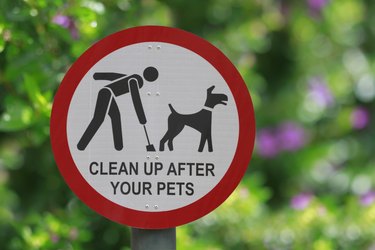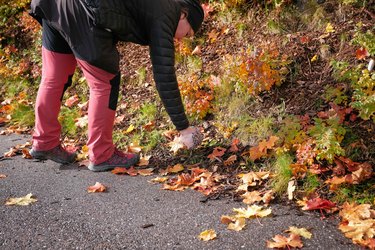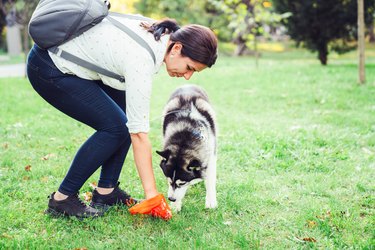Conventional wisdom says you can tell the quality of a diamond by its color, cut, clarity, and carat weight. Well, your dog doesn't poop diamonds, however, the characteristics of dog poo can provide you a wealth of information about your dog's health if you take the time to look. The four Cs of dog poop are color, consistency, content and coating, and all are indicators of what's going on inside.

Video of the Day
Dog poop color chart
Generally, a dog's stool is a chocolate-brown color; however, even healthy poop might vary a bit depending on their diet. If the color of their poop is different than normal, it could be from a variety of causes. A change in a dog's diet or dietary indiscretion can cause alterations in color, especially if your pet ate something containing artificial dyes. Health conditions can also prompt a change in stool color. Unusual dog poop colors might indicate the following about your pet's overall health:
Video of the Day
- Yellow dog poop: Food intolerance; liver or gallbladder issues
- Beige/tan dog poop: Parasitic infection, such as giardia; liver problems
- White dog poop: Excessive calcium intake
- Gray dog poop: Excessive fat intake or issues breaking down fat; exocrine pancreatic insufficiency
- Green dog poop: Gallbladder issues or ingestion of toxins, such as rodenticide
- Black dog poop: Intestinal bleeding higher in the gastrointestinal tract (small intestine)
- Red dog poop: Intestinal bleeding lower in the gastrointestinal tract (large intestine)

Dog poop shape and consistency
Ideally, your dog's poop should be shaped like a log. If they are passing small balls or pebble-shaped stool, it's an indication that they are not properly hydrated. It might be a simple matter of your dog not drinking enough water on one particular day, or it may be a sign of kidney disease. (Dogs with kidney disease often have excessive thirst and urination.)
When you pick up after your pup, you'll get a chance to learn about their poop's consistency. Ideally, it should be dough-like, holding its shape when you put it in the poop bag. It should leave behind no trace on the grass — this is sometimes referred to as coating . . . . it shouldn't coat the grass when it's picked up. If it's very firm and difficult to squish, it may indicate constipation. If there's no picking up that poop and you're instead scraping it off the ground because it's like soft-serve ice cream, your dog likely has some gastrointestinal upset. Digestive tract issues can result from something as simple as eating something they shouldn't have eaten, or your pet might have an infection, parasites, or food intolerance. If the poop is pure liquid, your dog has diarrhea.

Dog poop size is relative
If you have a large dog, they will naturally have larger feces. A petite pooch will have smaller poop. Sometimes, the volume may change, and your dog may have larger than normal bowel movements, which can indicate they're not digesting their food as well as they should.
On the other side of the coin, an unusually small amount of stool indicates that they may not be eating as much dog food as they should be. Other causes of excessively small stool can include constipation or partial obstruction. If they are not pooping at all, they might be severely constipated or obstructed.

What should I watch out for in my dog's poop?
Your dog's poop shouldn't be like a box of Cracker Jacks — you don't want any surprises inside. If it has streaks of bright red blood or mucus on it, the dog might have some inflammation in their colon. Poop that contains what looks like skinny noodles can indicate possible roundworms. Small, rice-like white spots or white specks might mean your dog has tapeworms.
If you see small, easily identifiable pieces of food in the poop, this might signal that the pet is not digesting their food efficiently. Grass in the stool means your dog probably ate vegetation. Some pet parents think their dogs eat grass to self-soothe an upset stomach, but they can actually consume turf for a variety of reasons, including behavioral reasons or simply because they like it. Red streaks in your dog's stool can point to health problems like colitis, bleeding from the rectum, or GI tract bleeding.

When should I be concerned about dog poop color?
A short-term change in dog poop color, shape, size, or consistency doesn't always mean your pet is ill — generally, a one-time deviation from their normal healthy deposit doesn't mean much. However, if it lasts for more than a couple of episodes, take your dog to a veterinarian.
A word of caution: If you think there is a possibility that your dog's stool change is due to toxin ingestion, an immediate trip to an emergency veterinarian is essential. If a dog eats certain older types of rat poison that include artificial colors, that can cause a dog's stool to appear bright green (many newer rat poisons do not contain dye or cause green poop). A large amount of bloody, watery diarrhea, which can indicate hemorrhagic gastroenteritis (HGE), should also be treated as an emergency.
Otherwise, pay attention to your dog's behavior to see how they're feeling. If their appetite is healthy and they're in good spirits, a strange poop here and there might not be cause for alarm. If your veterinarian includes a stool sample as part of your dog's routine wellness checks, it will help keep on top of intestinal parasites and address related health issues.
The bottom line
Your dog's poop should generally have the same appearance and frequency on a daily basis. However, small changes in color, amount, and consistency don't always mean the dog is sick. Pet parents should be aware of possible variations in dog poop color and what those might indicate for their dog's health. Anything from a diet change to a parasitic infection can cause a pet's stool to appear abnormal. It's best to consult a veterinarian to find out the exact cause or to address any other concerns regarding your dog's digestion and defecation.